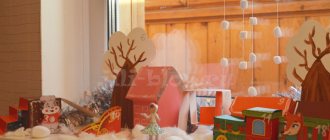Ready-made quest scenarios: ⇒ Quests for children (up to 10 years old) ⇒ Quests for teenagers (up to 16 years old) ⇒ Quests for adults (over 18 years old) ⇒ All quests for the NEW YEAR
Detailed description of the quest
A family quest for the New Year will allow you to give gifts in a fun and original way and congratulate the whole family on the New Year and Christmas holidays.
♦ Age of participants: the family quest is intended for adults and children to complete together . ♦ Target audience: all family members - children, mother, father, grandfather, grandmother, aunt, uncle, etc. ♦ Completion time: the total time to complete 10 cards with tasks is up to 30 minutes. ♦ Purpose of the quest: the New Year's quest for the whole family is intended to raise the New Year's family mood and, as a result, to present gifts (surprises) to the participants. After completing all the tasks, the participants of the family quest will find a box of gifts in the last cache. The quest is intended for the following holidays: ◊ family quest for the New Year ◊ family quest for Christmas ♦ Venue: New Year's quest for indoors - house, apartment, dacha. ♦ Number of participants: present family members participate in the quest, and accordingly the number of participants is not limited. ♦ Tasks: All tasks of the family quest are completely ready to be carried out. The organizer only needs to select the most suitable cards with hiding places, print them and hide them. The quest consists of 10 task cards and 10 hiding places, respectively. ♦ Quest genre: New Year's family quest with a search for gifts. ♦ Hiding places in the quest: ◊ Under the window ◊ In the freezer ◊ Bucket ◊ Computer ◊ Chair ◊ Under the carpet ◊ Stove ◊ Flower ◊ Vacuum cleaner ◊ Box in the closet ♦ Necessary props: - printed cards with tasks, - New Year's surprises (gifts) for members families. ♦ The finished quest kit includes three PDF files: 1. The file “Instructions for the quest” contains a detailed list of necessary actions to prepare the quest for implementation and a detailed explanation of algorithms for solving tasks. 2. The file “Quest without answers” contains 10 cards with tasks that the participants will need to solve.3. The file “Quest with answers” contains answers to all task cards. These files will need to be printed on a black-and-white or color printer. ♦ Other quests on the site:
Methodological recommendations “Creating a WebQuest”
MUNICIPAL STATE INSTITUTION DEPARTMENT OF EDUCATION OF THE ADMINISTRATION OF THE MUNICIPAL FORMATION "BARGUZINSKY DISTRICT" MBOU "BARGUZINSKAYA SECONDARY EDUCATION SCHOOL"
Prepared by: Kashenya G.V., teacher of history and social studies
Barguzin 2017
“Stages of working on a webquest”
A webquest in pedagogy is a problematic task with elements of a role-playing game, for the implementation of which information resources of the Internet are used.
A webquest is the most difficult for both students and teachers. The webquest is aimed at developing analytical and creative thinking skills in students; a teacher creating a webquest must have a high level of subject, methodological and infocommunication competence.
In order to clearly understand how to work on a webquest, we will first try to answer the question: “Why do you need to use webquests?”
Conducting project work using network resources has a number of specific advantages, and for teachers who are using the Internet for the first time in the classroom, web quest technology is a relatively easy way to learn how to use the World Wide Web for educational purposes. I will list its main advantages
:
- web quests provide the teacher with a clear model of how to carry out project work;
- The model of working with web quests is used by a huge number of teachers in various countries, so you can find many interesting developments on the Internet. You can start by selecting a finished product and using it as is (or perhaps with slight modifications);
- There are templates on the Internet that can be very useful for teachers who want to create their own web-quests, various tasks that are suitable for the proposed technology, a lot of methodological advice for teachers on how and where to find useful sites when creating a web-quest, and also a list of search engines and instructions for their use;
- The teacher provides a list of websites that students use to complete the project. As a result, they spend less time searching for the necessary information than completing the task;
- and finally, perhaps one of the most important reasons why you should use web-quest technology when teaching foreign languages is that many of your students will be happy to work using this technology to improve their language proficiency.
Stages of working on a webquest
The following stages of work on a webquest are distinguished:
1. At the first stage, the teacher carries out preparatory work, introduces the topic, and formulates the problem. Topics are selected so that when working on them, the student deepens his knowledge of the subject being studied or acquires new knowledge. The topics should be interesting and useful for students, so that the student can choose something to his liking and work, recognizing the need to solve the problem at hand. Several students can choose the same topic, the more interesting the discussion of the results will be, since the works can cover the topic from different points of view. Students become familiar with the basic concepts of the chosen topic and materials from similar projects. Roles in the team are distributed: 1-4 people per role. All team members should help each other and teach each other how to use computer programs.
2. At the stage of completing the task, students’ research skills are formed. When searching for answers to questions posed among a large amount of scientific information, critical thinking, the ability to compare and analyze, classify objects and phenomena, and think abstractly develop. Students acquire the skills to transform received information to solve problems. The accumulated experience of consistent actions under the guidance of a teacher will help everyone in organizing their further individual research activities in the global information space.
3. At the stage of formalizing the results of activities, the completed research is comprehended. The work involves selecting the most significant information and presenting it in the form of a web site, html page, slide show, booklet, animation, poster or photo report. At this stage, the role of the teacher as a consultant is very important.
4. Discussion of the results of work on web quests can be held in the form of a conference so that students have the opportunity to show their work, realizing the significance of the work done. The team nominates a person who will defend the project. The teacher may recommend that a student whose contribution to the work is minimal due to some reason (this may be the lack of a computer or Internet access at home, insecure work in HTML or graphic editors, poor logical and analytical thinking) can speak. Such a student, aware of his responsibility to the entire team, will make every effort to study the material, understand the problem, adequately present the project, and thereby receive at least a small increase in his professional competencies. At this stage, such personality traits as responsibility for the work performed, self-criticism, mutual support and the ability to speak in front of an audience are established. At the end of work on the project, after summing up the results, it is important to use material and moral incentives for high results.
Working with webquests can also be offered as homework for students interested in the subject; it can be done in the classroom if there are double lessons. This type of activity gives good results when preparing for the Olympiads, as it broadens one’s horizons and erudition. The actual placement of web quests on the network in the form of websites created by the children themselves can significantly increase the motivation of students to achieve the best educational results. At the end of work on the project, after summing up the results, it is important to use material and moral incentives for high results.
Webquest structure.
Webquests have been used for a long time and have acquired a clear structure.
However, it is not something fixed and is used only as a basis, which can be changed if necessary. You can design the quest according to the level and needs of your students. Typically, a quest is divided into four main sections: Introduction, Assignments, Completion, and Evaluation.
The first stage is Introduction. At this stage, preparatory work is carried out, familiarization with the topic occurs, and a problem is posed.
The Assignment section clearly and precisely explains what students must do while working on the quest. The task should provide motivation, be interesting for students and be tied to a specific life situation. Students are often involved in role-playing according to a given scenario.
Next comes the Execution stage. Students complete a series of assignments and conduct research using predefined web resources. The execution phase involves creating one or more finished products, which students then present at the end of the work.
Stage Evaluation involves self-assessment of the finished product, comparing it with products from other groups. Students not only present their work, but also draw conclusions about what they have learned and what they have achieved. During group work, they also evaluate their participation in the project and their personal progress. The teacher also evaluates the work, analyzes mistakes, and gives advice for future work.
Of course, such a structure may change, become more complicated, sections may have different names and be divided into subsections, but the above steps must be preserved.
Creation of webquests.
Creating a webquest does not require extensive technical knowledge. You can define the following groups of skills required to produce a quest:
- Research skills
- You must be able to search the Internet and quickly and accurately select resources. It is important to have the skill of working in various search engines and to be able to accurately formulate a question.
- Analytical skills
- It is also very important to critically evaluate the resources you find. Before giving assignments to students, you need to visit the proposed sites and make sure that they are suitable for completing the assignments and correspond to the level of the students.
- Knowledge of a text editor
- To combine text, pictures, and web links into a complete document, you need to be able to work with word processors. This can be learned in about 10-15 minutes.
- Before you sit down to create a webquest, it is always worth searching the Internet - perhaps someone has already created something similar that might be useful to you, and you do not need to waste time and effort reinventing the wheel.
Strong students who have experience working on the Internet can be asked to create their own quest on a topic that interests them. They should first be introduced to the structure of the quest and, if necessary, provided with a list of useful sites. Knowing that your work can be used as an assignment for other students can be very motivating.
So, to get acquainted with the algorithm for creating a webquest in more detail, follow the link: https://masterclasstopic2.jimdo.com/
How to create your own WEB-QUEST?
The process of creating a VK is not always linear, but there are certain steps that can be taken to create your own Web-Quest [BJ, Dodge, 2004]: Now on the Internet there are special sites for creating Web-quests, where you can find templates for the Web -Quest and detailed instructions for creating them (an example of the most popular English-language site for creating Web quests is https://questgarden.com/.)
It should be noted that the webquest can be issued both on paper and in electronic format.
- Step 1: Decide on a topic.
There are four conditions that the topic of your WebQuest must meet:
A) meet the requirements of state standards for the content of educational programs;
B) contain a task that will contribute to the development of a higher level of student thinking;
C) meaningfully replace or supplement existing materials on the topic of the lesson, the mastery of which you are not completely satisfied with on the part of the students;
D) use the Internet effectively.
- Step 2: select a site that has a matrix (template) for creating a webquest.
- Step 3: come up with tasks.
First, choose the form in which students will receive the assignment. There are several options:
* In the form of a presentation (for example, PowerPoint - .ppt extension) Place a picture on the slide and write one or two questions. So on each slide you can consider a specific topic.
* In text form (eg Word program - .doc extension). We place information with pictures and questions in the form of formatted text on an A4 or A3 sheet of paper.
* Visual material. It looks like a set of pictures, photographs, cartoons (you can attach it as an archive - .zip extension, since the size of applications is limited).
- Step 4: Come up with a grading system.
* The number of points awarded for a particular question.
* What number of points corresponds to what level (for example, 5 points – good).
* If there is no specific answer, then describe how to evaluate an oral story if it is reasoned, supplemented by your own knowledge, or, on the contrary, incomplete and inaccurate.
- Step 5: Find Sources of Information
, which students will use to find answers.
- Step 6:
Having a rough plan and basic information on the sheet,
start creating a Web-Quest
Webquest map
Developed based on the webquest template by B. Dodge
Name
______________________________________________________________________________________________________________________________________________________
- Introduction
_________________________________________________________________________________________________________________________________________________________________________________________________________________________________
A clear introduction that clearly describes the main roles of the participants (for example, “You are a detective trying to solve the mystery of a mysterious incident,” etc.) or a script, a preliminary work plan, an overview of the webquest.
- Task
_________________________________________________________________________________________________________________________________________________________________________________________________________________________________
A central task that is understandable, interesting and doable. The final result of the student’s independent or group work is clearly defined (for example, a series of questions are asked that need to be answered, a problem is spelled out that needs to be solved, and other activities are indicated that are aimed at processing and presenting the results based on the information collected).
- Resources
_________________________________________________________________________________________________________________________________________________________________________________________________________________________________
A list of information resources (in electronic form - on CDs, video and audio media, in paper form, links to Internet resources on the topic) necessary for the student to complete the assignment.
- Operating procedure
_________________________________________________________________________________________________________________________________________________________________________________________________________________________________
Description of the work procedure that must be completed by each student when completing the task independently or collectively (stages).
- Grade
_________________________________________________________________________________________________________________________________________________________________________________________________________________________________
Tell students how their work will be assessed. In the grading table, you can specify separate rubrics for individual and group work.
- Conclusion
:
_________________________________________________________________________________________________________________________________________________________________________________________________________________________________
A brief description of what students will learn by completing this webquest. You can also include rhetorical questions or additional references to encourage students to expand their knowledge beyond the WebQuest topic.
- Consultations
(optional for students)
_________________________________________________________________________________________________________________________________________________________________________________________________________________________________
Guidelines for action (how to organize and present the collected information), which can be presented in the form of guiding questions that organize educational work (for example, related to determining the time frame, general concept, recommendations for the use of electronic sources, presentation of “blank” reports).
- Recommendations
(optional for teachers)
_________________________________________________________________________________________________________________________________________________________________________________________________________________________________
Methodological recommendations for teachers who will use the webquest.
- Resources used
/
Acknowledgments
/
Copyright information
(additional)
Links to resources used to create the webquest / Thanks to the authors of the resources used / Information about the terms of use of the webquest materials.
I hope this template will help you create interesting webquests that will expand the world of knowledge and information for your students. Good luck and happy travels!
- Step seven.
When all the pages are completed, the WebQuest is ready for placement on the site and
can be published.
Web-Quest will become available to others only after publication.
“Introduction to the
JIMDO ”
STEP No. 1
Open the registration page - address www.jimdo.com and fill out the form (see screenshot No. 1)
- Let's come up with a login.
- Enter your email address.
- Put a tick in the “Terms of use...” box
- Click the “Create a website for free” button
- Enter test words.
- Click the “Create a website for free” button
7. Go to your mailbox.
8. The received letter contains a link to the site and a password to log in. Copy the password and go to your website using the link. (Important!!!!!!!!! Write down the address and password of your site.)
Congratulations! You are on your website! We will use this site to create a training quest. In the future, you will independently create another website, which will be the basis of your author’s quest.
So, we move on to working on the jimdo platform.
Step 9: At the bottom of the page you see a rectangular window with the information “Click on the Login link and enter your password!” Click on the active “LOGIN” link.
10. In the dialog box that opens, paste the copied password and click “LOGIN” and find yourself in the site editing panel.
11. In the site control panel, on the right is the main menu (OM). Here you can select a template (W), change the text style (C) and set basic site settings.
12. Now we will start choosing a template for your website. Go to the “TEMPLATE” menu. In the window that opens, the templates tab is already active (highlighted in blue). Below it there are two icons: vertical location (V) and horizontal location (D).
13. Select the vertical arrangement of the templates. This is necessary in order to immediately see the properties that your chosen template has . (Tip! Choose a template whose properties have all the green checkmarks. This gives you more opportunities to change the design of your quest.)
Next, click “SELECT TEMPLATE”.
14. An active “PREVIEW” window opens above the header of your site. If you are satisfied with the template you have chosen, click “YES”; if you want to change the template in a way that does not suit you, click “BACK”; if you decide that you are satisfied with your previous template, click “NO”.
15. Now we change the site header. We move the cursor over the menu of your site, the “CHANGE WEBSITE HEADER” window pops up (Tip: we move the cursor from bottom to top)
16.Click on the pop-up window “CHANGE SITE HEADER”. In the window that opens you see the following tabs:
1. Gallery - allows you to select a picture of the header of your quest;
2. Own image - allows you to select a picture from your computer.
Algorithm of actions: Own image—Browse—Select a previously saved picture—Open—Close.
3. Sample - allows you to choose the color of the header and graphic design.
Algorithm of actions: Sample—In the color panel, select a color (CP)—In the gallery of graphic templates (GS), select the one you like.
So, as you probably remember, we will create a webquest with you. The theme of the quest, for example, is “Ivan the Terrible.”
Rear No. 1. Change the header image of the site in accordance with the theme of the quest “Ivan the Terrible”.
17. Heading. Open the “CHANGE WEBSITE HEADER” pop-up window. Next is the “TITLE” tab. In the window that opens, erase the proposed entry. Type in the following information:
Ivan groznyj
Full name
School
Village, district
Important! We type the necessary information rather than copy and paste.
Position (sliders - horizontally and vertically - adjust the position of the inscription along planes;
Font size - the size of the font of your inscription;
Color palette (CP) - the color of the inscription.
Task No. 2. Make a title for the header of your quest.
18. Let's move on to editing the menu. We move the cursor over the site menu. The “EDIT NAVIGATION MENU” pop-up window appears. Click.
19.A pop-up window appears. We remove the names of the original page names and type in the names in accordance with the structure of the quest. Select Save-Collapse.
20. Let's start working on the quest. Select the “Home” tab in the site menu. We read the information that is on the main page.
You won't need it anymore; we'll delete it. To do this, we follow the algorithm: Move the cursor over the block of information that we want to delete—Highlight—Select the trash can—Click—Confirm deletion. In this way we delete all information on the “Home” page.
21. Filling out the “Home” page
Select “ADD NEW ELEMENT”. Select the “TEXT” tab
22. In the text field of the window that opens, copy and paste the following text:
Ivan IV Vasilyevich , nicknamed the Terrible , by the direct name Titus and Smaragd [4] , tonsured - Jonah ( August 25 1530 , the village of Kolomenskoye [5] near Moscow - March 28 1584 , Moscow) - sovereign , Grand Duke of Moscow and of All Russia since 1533 , the first Tsar of All Russia (since 1547 ; except for 1575 - 1576 Simeon Bekbulatovich was nominally the “Grand Duke of All Russia” ).
The eldest son of the Grand Duke of Moscow Vasily III and Elena Glinskaya . On his father's side he came from the Moscow branch the Rurik dynasty , on his mother's side - from Mamai , who was considered the ancestor of the Lithuanian princes Glinsky [6] [7] . Paternal grandmother, Sophia Palaeologus - from the line of Byzantine emperors [8
Inserted—Selected—Centered—If necessary, made ITALICS or BOLD. If you decide to change the font color, you can do this in two ways:
- In the graphic editor we selected “A” and selected the desired color.
- Second method: In the right toolbar, select the “STYLE” tab. The “FONT FORMAT” tab is active. Select the “TEXT” tab. Here we set the FONT TYPE, FONT SIZE, etc. When you have completed all operations to customize the text, scroll down the slider and select “SAVE”.
In the “PREVIEW” pop-up window, select “YES”.
Important! If you have configured the text in this way, it will be displayed on all pages of the site the way you configured it. You can change the font size ONLY this way!
We also customize Headings, links and separators.
PREVIEW - YES!
Important! If after you changed the font size and saved the changes, the font adjustment did not occur, perform the following algorithm:
Select a block of text—Select the trash can—Confirm deletion—Add an element—Text—Insert as TEXT tab—click—Insert the text into the field that appears—Insert—Save.
To view your work as a user, BOTTOM OF THE PAGE VIEW
.
Instructions for creating a webquest on Google:
— select the “CREATE” tab;
— in additional templates, select the category of schools and educational institutions;
— select a webquest site;
— assign a site name, address
Instructions (manuals) for creation and design
Links: https://docs.google.com/presentation/d/1m7R6yFB9STfeOTjNLw7pKEagBFMsgIhmDoNS8bErJdY/edit#slide=id.g5d318ea57_00
https://docs.google.com/presentation/d/1aHA-iYvtamLglOuEqi4TeyD-R1fyAZuOyO8oKpxfBBM/edit#slide=id.p
The webquest has been created, you can proceed to filling it out
Literature
1. Andreeva M. V. Web quest technologies in the formation of communicative and sociocultural competence // Information and communication technologies in teaching foreign languages. Abstracts of reports of the I International Scientific and Practical Conference. M., 2004.
2. Bykhovsky Ya. S. Educational web quests // Materials of the international conference “Information technologies in education. ITO-99". — https://ito.bitpro.ru/1999
4. Nikolaeva N.V. Educational quest projects as a method and means of developing students’ information activity skills // Issues of Internet education. 2002, no. 7.
5. Dodge B. Some Thoughts About WebQuests. 1995-1997. — https://webquest.sdsu.edu/about_webquests.html
6. March T. What's on the Web? Sorting Strands of the World Wide Web for Educators. 1995-2001. — https://www.ozline.com/learning/webtypes.html
7. March T. Working the Web for Education. Theory and Practice on Integrating the Web for Learning. 1997-2001. — https://www.ozline.com/learning/theory.html
8. March T. Web-Quests for Learning. 1998. - https://www.ozline.com/webquests/intro.html
9. Dodge B. WebQuest Taskonomy: A Taxonomy of Tasks. 1999. - https://webquest.sdsu.edu/taskonomy.html
10. Lamb A. Locate and Evaluate WebQuests. 2000-2004 / EduScapes. Teacher Tap. Internet resources.Webquests. — https://eduscapes.com/tap/topic4.htm
11. Dodge B. A Rubric for Evaluating WebQuests. 2001. -https://webquest.sdsu.edu/webquestrubric.html
12. Dodge B. Creating A Rubric for a Given Task. 2001. -https://projects.edtech.sandi.net/staffdev/tpss99/rubrics/rubrics.html
13. March T. Criteria for Assessing Best WebQuests. 2002-2003. -https://www.bestwebquests.com/bwq/matrix.asp
14. Bauer-Ramazani Chr. WebQuests Resource Page. 1998-2005. -https://academics.smcvt.edu/cbauer-ramazani/Links/webquests.htm
15. The WebQuest Page. Reading and Training Materials. 1998-2005. https://webquest.sdsu.edu/materials.htm
16. Personal website of Natalia Pop
https://natapop.ru/index/rekomendacii_veb_masteru/0-234
17. Webquest as a way to enhance students’ learning activities
Romantsova Yulia Vyacheslavovna
https://festival.1september.ru/articles/513088/
19
Quest plot
If you want to wish all family members a Happy New Year and Merry Christmas in an original way, then this quest is just for you. ♦ BEGINNING of the quest: The main idea of the quest is that a letter from the Snow Maiden was found in the mailbox, in which she reports that Santa Claus has been kidnapped and the gifts will not be delivered. She turns to your family for help, as the most courageous and resourceful family. The quest kit contains all the necessary materials for preparation - a letter layout and an envelope for printing. Participants in the quest can be people of any age category. The quest tasks will be of interest to both children, teenagers and parents (adults). In her letter, the Snow Maiden addresses your family members, in which she writes: ♦ Text of the letter: “If you found this letter, it means that Santa Claus still hasn’t arrived to you. The last time he was seen was by the gnomes at the threshold of your house and so I decided to immediately contact you! In general, knowing these places, help us urgently find the old man so that he can finally deliver gifts to everyone: both children and adults, otherwise what would New Year be without Grandpa? Most likely, these searches will be very dangerous, because Grandfather has recently received anonymous threats demanding that he leave the bag of gifts in a secret place. So, be very careful, because you are the only hope! So, as usual, Santa Claus equipped the sleigh with gifts, harnessed the horses and set off, but something happened on the road and the sleigh arrived without him. But Grandfather is not so simple, and even if he was kidnapped, he would find a way to leave a trace or notes by which he could be found... "
The Snow Maiden's letter itself contains the first puzzle of the quest, which the participants will have to solve. After solving the puzzle, will participants find out the name of the cache? in which a secret note from Santa Claus is hidden. This note will begin a fun, exciting New Year's quest for the whole family. Finding such notes and solving one task after another? participants will approach the main cache. ♦ COMPLETION of the quest: After the quest participants find and solve all the secret notes of Grandfather Frost, the final cache will contain another letter in which Santa Claus brings congratulations to the participants who saved the New Year and freed him from the captivity of the kidnapper. In the final cache, in addition to a congratulatory letter, participants will also receive New Year's gifts (surprises) from the quest organizer. Text of the letter: “Well done, brothers! My main hiding place was found. Having found a secret nook, you opened the bag in it. And at the same hour, in response, the Star jumped out of the bag unnoticeably. As soon as she shot up, the New Year's miracle unfolded in the sky. My kidnapper hugged me and gave me all the gifts. And he said that I should quickly distribute them to the people of the world. So I give you a gift, I wish you happiness and joy in the New Year! I am also sincerely grateful to you that you did not take the miracle lightly. They believed in me, didn’t let me down, and saved the New Year for everyone!”
All quest tasks are designed in such a way that, at the request of the organizer, any cards can be removed or their sequence can be changed. This opportunity will allow the organizer to construct his ideal quest using suitable hiding places and tasks.
Quest “In Search of New Year's Treasures”
Unravel the word. There are “strange” words written on the sheets.
The letters in them must be rearranged so that the word ceases to be “strange”.
Kalyo - (Yolka); Rwanya - (January); kashuplo - (cracker); Retev - (Wind); varyan - (January); Ndamarin- (Mandarin);
Levanki - (Valenki); Neguchsorak – (Snow Maiden); nikasnezh - (snowflake); Negs - (Snow); bredak - (December); rose – (frost)
A phrase is specified where each word is “inverted” to its opposite meaning. The players' task is to guess what this phrase is.
Book titles:
Rainy King (Snow Queen)
Zharilko (Morozko)
120 weeks (12 months)
The morning after Easter (The night before Christmas)
Lines from songs:
You will read them a story in fifty seconds (I’ll sing you a song about five minutes)
White, white dew stood over the cable (Blue, blue frost lay on the wires)
The poplar tree died near the park, it dried up near the park (A Christmas tree was born in the forest, it grew in the forest)
Yes, they dragged you; yes, they dragged you from a quiet, sultry place, 9 black goats, uh, 9 black goats - Tuesday, Wednesday and Thursday (And they carry me away, and carry me away, into the ringing snowy distance Three white horses, oh, three white horses - December, and January and February)
The big cypress is hot in the summer (the small Christmas tree is cold in the winter)
The brave little black wolf was sitting on an oak tree (the cowardly little gray bunny was jumping under the Christmas tree)
The rain whispered a poem to him: “Get up, oak tree, come on, come on” (The snowstorm sang a song to her: “Sleep, bye-bye Christmas tree”)
Oh, it's hot, it's hot! Cool it down! Cool him, our camel! (Oh, frost, frost! Don’t freeze me! Don’t freeze me, my horse!)
Station
“Ice flakes, snowflake, snowdrifts”
Game
“Ice flakes, snowflake, snowdrifts”
When they hear the word “ice flakes,” everyone freezes, holding their hands joined together upward. When they hear the word “snowflakes,” everyone starts spinning around themselves. When they hear the word “drifts,” everyone crouches.
Game
“There are Christmas trees”
We decorated the Christmas tree with different toys, and in the forest there are different Christmas trees, wide, low, tall, thin. Now, if I say “high,” raise your hands up. “Low” - squat and lower your arms. “Wide” - make the circle wider.
Game "New Year's Train"
A cheerful children's song is turned on, for example, “The little Christmas tree is cold in winter.”
The guys, singing along, move around the tree in one direction, then the direction changes. Game "New Year's Round Dance"
One of the most common and favorite children's New Year's games. Children stand around the Christmas tree, holding hands together. A cheerful children's song is played, for example, “A Christmas tree was born in the forest.”
Station "Mysterious"
To get part of the postcard, you must solve all the riddles.
1. I powdered the paths and painted the windows. Gave joy to the children. And took me on a sled (Winter)
2. If the forest is covered with snow, you won’t find any leaves at all. Like a beauty, slim, and important for the New Year. (Christmas tree)
3. If it smells like pies, if a Christmas tree comes into the house, what kind of holiday is it? …(New Year)
4. New Year's balls are the best gift for children. Fragile, fabulous and bright, this festive... (gift).
5.He draws palm trees, stars, and gingerbread cookies on the glass. They say he is a hundred years old, but he plays pranks like a little boy (frost)
6. The hedgehog looks like her, you won’t find any leaves at all. Like a beauty, slim, and important for the New Year (Christmas tree).
7. The children made him out of snow, they attached a nose out of carrots. They even gave him a scarf so that he wouldn’t freeze in the severe frost.
Who does every child know, in the yard outside the window stands a friend of the boys and a friend of the girls, a kind plump one... (snowman)
8. All carved, lace - light fluff. White ones flew to us from the sky... (snowflakes)
9. I have gifts of caramel and chocolates in my bag. There is a round dance around the Christmas tree, what kind of holiday? … (New Year)
10. Today we were so tired, we sang songs and danced. Even though it’s winter, it’s hot here and they’re waiting for us in a bag... (gifts)
11. It’s time to light the Christmas tree, have fun and dance, we’ll shout one, two, three, together, Christmas tree... (burn)
12. All dressed up in toys, all in garlands and firecrackers. Not prickly at all, but of course it’s... (Christmas tree)
13. The holiday came to us at midnight. How the people waited for him! Gathered around a green Christmas tree... Round dance
14. As if it were real, there is always a familiar, shiny, burning star on the Christmas tree...
15. A bucket, instead of a hat, I’ve been used to wearing it for a long time, With a carrot instead of a nose, Cheerful... Snowman 16. They brought it from the forest It’s green, All the needles sparkle, Of course it’s... Christmas tree 17. And everyone here at the holiday Dances and sings. We are so happy to congratulate everyone On the wonderful... New Year 18. It curls like a spiral Only it is alone, And across the hall we throw Beautiful... (serpentine). 19. Frost shouts, tries: Hey, Christmas tree, shine! And immediately the circles…(confetti) fly up. 20. We will always decorate and decorate the hall for the New Year. Shines, shimmers, Sparkles... (tinsel). 21. And, showing off their outfits, the people make noise around. We are so happy to congratulate everyone on a wonderful... (New Year)
Station
"Sportivnaya"
Marksman
Select a suitable target. This can be a bucket or basket. The guys must use paper balls (snowballs) to hit the target and earn their team a certain number of points and defeat their opponents.
winter wind
To play, prepare a ball rolled out of paper or a wad of medical cotton wool.
Place it in the middle of the table. The goal of the game is for players to try to blow it to the floor as quickly as possible. Decorate the Christmas tree.
Divide the children into two teams. Place a box of Christmas tree decorations next to each team. It is advisable that they are not made of breakable glass. Otherwise, in the chaos they will quickly break. Each team of players is provided with two Christmas trees. Players from each team must run from the start to the Christmas tree and hang the toy taken from the box. The game continues until the decorations run out. The fastest team to decorate their tree wins.
Cap
The guys stand in a circle and pass each other a New Year's cap. All this time there is music playing. As soon as the sounds subside, we see who has the headdress in their hands. Whoever gets caught tells Santa Claus a poem about winter or sings a song.
Competition "Help Grandfather"
Children are divided into two teams. Their task is to help Santa Claus pack gifts. One person runs a relay race with a bag and puts toys and candies out of it, and runs back. The second participant runs along the same route and collects everything back into the bag.
Children collect the picture and run for gifts.
Quest tasks
All task cards have a cheerful festive theme with New Year's decoration. The main goal of all tasks is to declassify all the secret notes of Santa Claus, free him from the hands of the kidnappers and save the New Year. But only a select few can unravel and decipher Grandfather’s magical notes! It’s up to you to decide whether or not to be a brave, resourceful, chosen family to go on a fun New Year’s adventure.
Description of tasks in the quest: ◊ Letter from the Snow Maiden - a task in which participants need to pay attention to the magical sleigh of Santa Claus. It is in them that a puzzle is hidden, after solving which the participants will find out the location of Grandfather’s next note. ◊ Mysterious message - a task in which Grandfather encrypted the meaning of some words with New Year's symbols. If participants guess that each letter of the hidden word is replaced with a specific symbol, then the message will be deciphered. ◊ New Year's tracks - an interesting task in which family members need to guess which animals the tracks are depicted in the snow. Having done everything correctly, it will immediately become possible to collect the name of the next cache. ◊ Fir trees and sticks - an attentive task in which you need to find half of each fir tree. Having done everything correctly, the next cache will be found. ◊ Winter sports is an interesting task in which, based on the emblems of the Winter Olympic Games, participants need to guess their name and write it in the appropriate boxes. Having done this, Santa Claus's secret hiding place will be found. ◊ Decorated Christmas tree - a fun task in which all family members will have to correctly assemble Christmas tree decorations, and then the name of the secret hiding place will become known. ◊ Grandfather's Gifts is an interesting puzzle in which you need to logically guess under which Christmas tree, which gift Santa Claus will put. Having placed all the gifts correctly, you will find that very secret hiding place. ◊ One, two, three Christmas trees are a logical task in which you need to find the beginning of a magic garland. As soon as the beginning of the garland is found, participants will be able to read the text of Santa Claus' riddle. The answer to the riddle will be the next hiding place. ◊ Gift Labyrinth - a task in which participants will have to navigate a labyrinth of New Year's gifts. The final gift in the maze will be Santa Claus' hiding place. ◊ New Year's Rhythms - a musical task in which participants will have to guess the name of famous New Year's songs using emoticons, which will help to guess the name of the main cache.
You can read reviews about our quests here “Reviews”.









